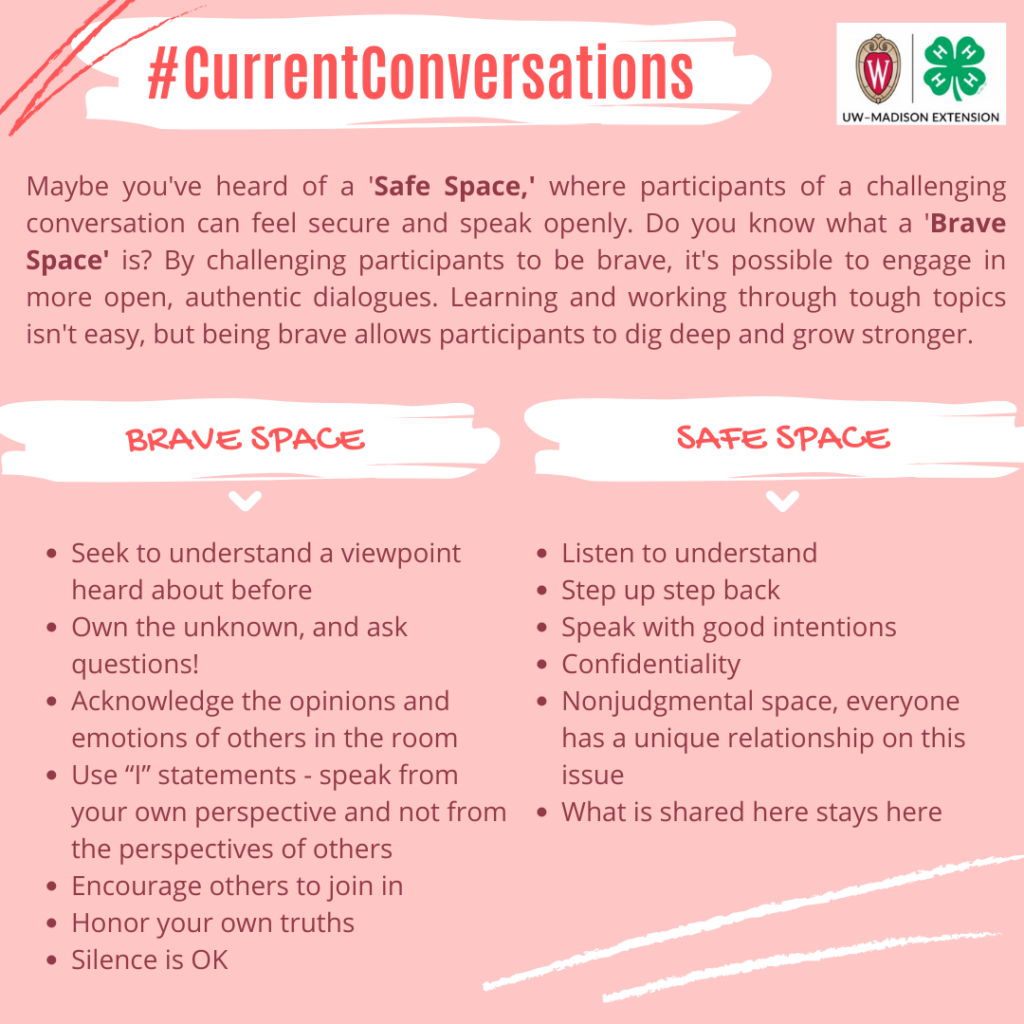Brave and Safe (Enough) Space
Having a difficult conversation requires having a plan. Learn more about the skills you can practice every day!
Research shows that learning and growth happen when we step out of our comfort zones and push ourselves to think about ideas and experiences that we haven’t heard about or previously considered. When we intentionally create a space where participants feel safe and brave, participation and learning increase. At first you may think of the components of Brave and Safe Space as group norms, expectations, or agreements.
Our youth leaders learned that the bullet points are skills we are constantly building in ourselves and modeling for others. This means we are always creating a safe ‘enough’ space.
A safe ‘enough’ space mean that each participant may hold different privilege and each participant has the capacity to do harm and the responsibility to recognize and repair harm. We also believe that learning can feel hard. Those feelings are okay and we can talk about them. It is especially important to talk about feelings like discomfort, disappointment, confusion, anger, and others that we may try to hide.
Brave Space
A brave space is acknowledging that we will probably feel uncomfortable at some point in this conversation, so we will participate to grow and learn.
- Seek to understand a viewpoint you haven’t considered or heard about before
- Own the unknown, and ask questions
- Acknowledge the opinions and emotions of others in the room
- Brink your authentic self
- Use “I” statements – speak from your own perspective and not from the perspective of others
- Encourage others to join in
- Honor your own truths
- Silence is ok
- Asking questions & vulnerability will be seen as strength!
Safe Space
A safe space is creating and maintaining the expectation that all voices are heard, listened to, and valued, and taking steps to ensure this.
- Listen to understand
- Step up step back/make space take space
- Speak with good intentions
- Confidentiality
- Nonjudgmental space, everyone has a unique relationship to the issue, different life experiences and knowledge levels
- What is shared here stays here (personal stories/examples/emotions/etc. shared by others) but you take the learning with you
Examples
Our Current Conversations Team (made up of youth and adults) made the following observations about Brave and Safe Space on its ‘lessons learned’ brainstorm.
“Even when we have established Brave and Safe Space with a group before, we like to do the activity again in a modified format such as sharing which of the bullet points are important to each person. Brave and Safe space is a great way to break the ice in a group.”
You can co-create a Safe Space/Brave Space in different ways:
Most importantly this space is one where confidentiality is practiced. Our learning travels with us, but the personal details and experiences shared by others remain private.
- Provide time for participants to generate ideas on their own to create a brave/safe space
- Break out into small groups and then come together and share out ideas
- Present a list of ideas and have participants select items that speak to them
The space we refer to is our group engagement, but you can create safe/brave spaces in our lives one on one with family and friends or in groups to which we belong. Participants are also creating a Safe Space/Brave Space within themselves as they set goals, make decisions about who and when to engage, build skills to have conversations and make positive change around them.
Always remember, our purpose is to learn not to find ‘right’ answers nor to convince any participant to hold a particular point of view. Participants emphasized the importance of developing their ability to create Brave and Safe spaces in their communities. These include:
- how to moderate a difficult conversation
- how to support someone being bullied
- how to advocate for a change at school, characteristics of an ally or accomplice.
Below are some key characteristics of what ‘safe’ can look and feel like and what ‘brave’ can look and feel like. Have participants either verbally or symbolically agree to the characteristics. If they cannot agree, ask them to participate later.
Brave and Safe Space Resources
- Workshop presentation that included information about Brave and Safe Spaces at Fall Forum 2020.
- Antiracist practices (lesson from PBS)
- Microaggressions Are A Big Deal: How to Talk Them Out and When To Walk Away (from NPR)
- Role of Mindfulness The Inner Work of Racial Justice (TedX talk by Ronda Magee)
- Civil Discourse Online (curriculum from Common Sense Media)






